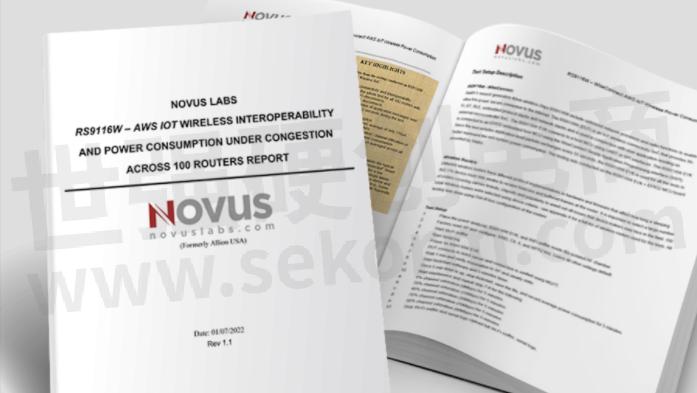Novus Labs‘ test report on 100 routers shows RS9116 Robust low-power Wi-Fi Interoperability

Recent Novus Labs Report analyzes Silicon Labs’ RS9116W IoT Wi-Fi connectivity capabilities and power consumption under congestion for 100 wireless routers.
True IoT requires cloud connectivity. In that regard, connecting a device to the Internet as quickly as possible is an important design consideration for manufacturers. Just as important is the power consumption of these ubiquitous, always-on devices like smart watches and video doorbells. A lot of variables impact how a device manages connectivity and power consumption. In an effort to better understand how our RS9116W Wi-Fi module performs across routers, we enlisted Novus Labs, a global engineering solutions provider, to evaluate these metrics.
The RS9116W has single and dual band, multiprotocol wireless SoC and modules for 802.11 b/g/n (2.4 GHz) and dual-mode Bluetooth 5.0. It supports 20 MHz Wi-Fi channel and has a transmitting power of up to 18 dBm (Wi-Fi) and 16 dBm (Bluetooth) with an integrated PA. It has integrated Wi-Fi, Bluetooth, and TCP/IP Networking stacks and is designed to provide good throughput, extended range, and power-optimized performance. Novus Labs performed a 25-minute test for each router to check for interoperability and measure the power consumption under different levels of network congestion.
If you’re a device vendor considering Silicon Labs hardware the results of this study might be helpful in your selection process.
Based on our own studies, we know lower power consumption with an always-ON AWS cloud connection under congestion translates to longer battery life in the real-world. With this in mind, Novus Labs considered varying congestion scenarios in their testing to check for interoperability and quantify the impact on battery life. By varying the congestion in the network, they mimic different home and office environments that IoT devices generally are installed in. Two extreme scenarios considered as part of this testing are looking at a low-congestion example of a single-family home with wireless traffic limited to single television and a few smartphones and laptops. The second one is a high congestion, typical for apartments or hotels, or office and retail environments. The testing was conducted over several weeks, with 100 different popular access points from vendors all over the world, with varying congestion for interoperability and power consumption. The results show no interoperability issues, such as disconnects with access points, or with the AWS cloud. In addition, the RS9116 sustained its ultra-low power operation across multiple routers under various congestion scenarios. In fact, the average power consumption increased by only 248 uA for highly saturated channels.

The graph shows the current consumption for each channel congestion % averaged over all 100 routers used in the test.
In today’s feature-packed IoT devices, coexistence is necessary. It’s also exceedingly complex. Our Wi-Fi portfolio features industry-leading modules and SoCs as well as software solutions to provide a robust system-level approach to application development. This dramatically simplifies the wireless design requirements, freeing you to focus more time on the application itself. Read the complete Novus Labs RS9116W report and learn more about our extensive Wi-Fi IoT Solutions.
- +1 Like
- Add to Favorites
Recommend
- New Matter Solution from Silicon Labs Unifies the IoT Connectivity Experience
- Silicon Labs Simplifies IoT Development with Simplicity Studio 5
- Silicon Labs Strengthens Isolated Gate Driver Portfolio
- Software Speeds Development of IEEE 1588 System Integration | Silicon Labs
- Silicon Labs Expands Isolated Gate Driver Product Family Ideal for Hybrid and Electric Vehicles (EV)
- News | Silicon Labs and Amazon Collaborate on Sidewalk, a New Shared Network for IoT Consumer Devices
- Silicon Labs Low-Power Wi-Fi Ideal for Energy Efficient IoT Devices
- Silicon Labs and Skyworks reach agreement to sell infrastructure and automotive business
This document is provided by Sekorm Platform for VIP exclusive service. The copyright is owned by Sekorm. Without authorization, any medias, websites or individual are not allowed to reprint. When authorizing the reprint, the link of www.sekorm.com must be indicated.






























































































































































































































































































































































































































































































































































































































































































































































































































































































